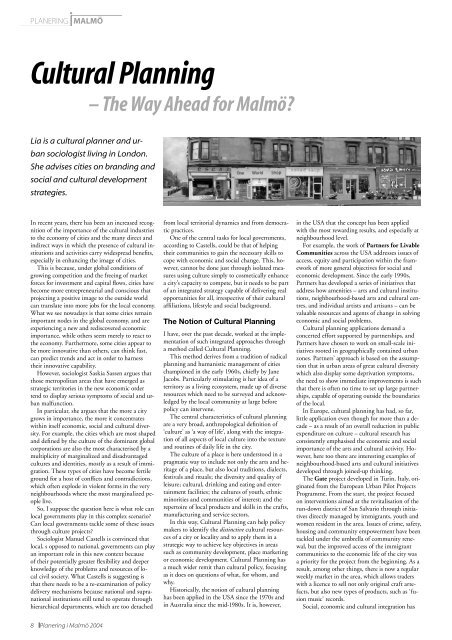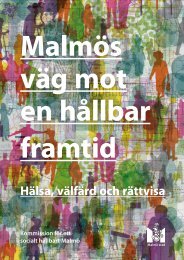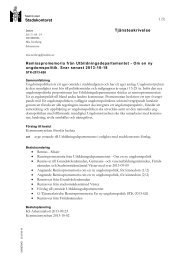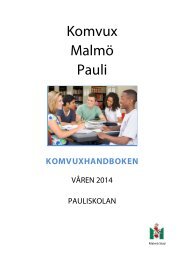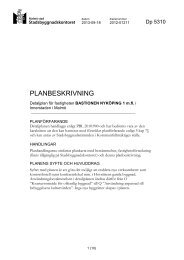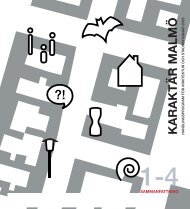PIM2 2004.indd - Malmö stad
PIM2 2004.indd - Malmö stad
PIM2 2004.indd - Malmö stad
Create successful ePaper yourself
Turn your PDF publications into a flip-book with our unique Google optimized e-Paper software.
Cultural Planning<br />
Lia is a cultural planner and ur-<br />
In recent years, there has been an increased recognition<br />
of the importance of the cultural industries<br />
to the economy of cities and the many direct and<br />
indirect ways in which the presence of cultural institutions<br />
and activities carry widespread benefits,<br />
especially in enhancing the image of cities.<br />
This is because, under global conditions of<br />
growing competition and the freeing of market<br />
forces for investment and capital flows, cities have<br />
become more entrepreneurial and conscious that<br />
projecting a positive image to the outside world<br />
can translate into more jobs for the local economy.<br />
What we see nowadays is that some cities remain<br />
important nodes in the global economy, and are<br />
experiencing a new and rediscovered economic<br />
importance, while others seem merely to react to<br />
the economy. Furthermore, some cities appear to<br />
be more innovative than others, can think fast,<br />
can predict trends and act in order to harness<br />
their innovative capability.<br />
However, sociologist Saskia Sassen argues that<br />
those metropolitan areas that have emerged as<br />
strategic territories in the new economic order<br />
tend to display serious symptoms of social and urban<br />
malfunction.<br />
In particular, she argues that the more a city<br />
grows in importance, the more it concentrates<br />
within itself economic, social and cultural diversity.<br />
For example, the cities which are most shaped<br />
and defined by the culture of the dominant global<br />
corporations are also the most characterised by a<br />
multiplicity of marginalized and disadvantaged<br />
cultures and identities, mostly as a result of immigration.<br />
These types of cities have become fertile<br />
ground for a host of conflicts and contradictions,<br />
which often explode in violent forms in the very<br />
neighbourhoods where the most marginalized people<br />
live.<br />
So, I suppose the question here is what role can<br />
local governments play in this complex scenario?<br />
Can local governments tackle some of these issues<br />
through culture projects?<br />
Sociologist Manuel Castells is convinced that<br />
local, s opposed to national, governments can play<br />
an important role in this new context because<br />
of their potentially greater flexibility and deeper<br />
knowledge of the problems and resources of local<br />
civil society. What Castells is suggesting is<br />
that there needs to be a re-examination of policy<br />
delivery mechanisms because national and supranational<br />
institutions still tend to operate through<br />
hierarchical departments, which are too detached<br />
8 Planering i <strong>Malmö</strong> 2004<br />
– The Way Ahead for <strong>Malmö</strong>?<br />
ban sociologist living in London.<br />
She advises cities on branding and<br />
social and cultural development<br />
strategies.<br />
from local territorial dynamics and from democratic<br />
practices.<br />
One of the central tasks for local governments,<br />
according to Castells, could be that of helping<br />
their communities to gain the necessary skills to<br />
cope with economic and social change. This, however,<br />
cannot be done just through isolated measures<br />
using culture simply to cosmetically enhance<br />
a city’s capacity to compete, but it needs to be part<br />
of an integrated strategy capable of delivering real<br />
opportunities for all, irrespective of their cultural<br />
affiliations, lifestyle and social background.<br />
The Notion of Cultural Planning<br />
I have, over the past decade, worked at the implementation<br />
of such integrated approaches through<br />
a method called Cultural Planning.<br />
This method derives from a tradition of radical<br />
planning and humanistic management of cities<br />
championed in the early 1960s, chiefly by Jane<br />
Jacobs. Particularly stimulating is her idea of a<br />
territory as a living ecosystem, made up of diverse<br />
resources which need to be surveyed and acknowledged<br />
by the local community at large before<br />
policy can intervene.<br />
The central characteristics of cultural planning<br />
are a very broad, anthropological definition of<br />
‘culture’ as ‘a way of life’, along with the integration<br />
of all aspects of local culture into the texture<br />
and routines of daily life in the city.<br />
The culture of a place is here understood in a<br />
pragmatic way to include not only the arts and heritage<br />
of a place, but also local traditions, dialects,<br />
festivals and rituals; the diversity and quality of<br />
leisure; cultural, drinking and eating and entertainment<br />
facilities; the cultures of youth, ethnic<br />
minorities and communities of interest; and the<br />
repertoire of local products and skills in the crafts,<br />
manufacturing and service sectors.<br />
In this way, Cultural Planning can help policy<br />
makers to identify the distinctive cultural resources<br />
of a city or locality and to apply them in a<br />
strategic way to achieve key objectives in areas<br />
such as community development, place marketing<br />
or economic development. Cultural Planning has<br />
a much wider remit than cultural policy, focusing<br />
as it does on questions of what, for whom, and<br />
why.<br />
Historically, the notion of cultural planning<br />
has been applied in the USA since the 1970s and<br />
in Australia since the mid-1980s. It is, however,<br />
in the USA that the concept has been applied<br />
with the most rewarding results, and especially at<br />
neighbourhood level.<br />
For example, the work of Partners for Livable<br />
Communities across the USA addresses issues of<br />
access, equity and participation within the framework<br />
of more general objectives for social and<br />
economic development. Since the early 1990s,<br />
Partners has developed a series of initiatives that<br />
address how amenities – arts and cultural institutions,<br />
neighbourhood-based arts and cultural centres,<br />
and individual artists and artisans – can be<br />
valuable resources and agents of change in solving<br />
economic and social problems.<br />
Cultural planning applications demand a<br />
concerted effort supported by partnerships, and<br />
Partners have chosen to work on small-scale initiatives<br />
rooted in geographically contained urban<br />
zones. Partners’ approach is based on the assumption<br />
that in urban areas of great cultural diversity<br />
which also display some deprivation symptoms,<br />
the need to show immediate improvements is such<br />
that there is often no time to set up large partnerships,<br />
capable of operating outside the boundaries<br />
of the local.<br />
In Europe, cultural planning has had, so far,<br />
little application even though for more than a decade<br />
– as a result of an overall reduction in public<br />
expenditure on culture – cultural research has<br />
consistently emphasised the economic and social<br />
importance of the arts and cultural activity. However,<br />
here too there are interesting examples of<br />
neighbourhood-based arts and cultural initiatives<br />
developed through joined-up thinking.<br />
The Gate project developed in Turin, Italy, originated<br />
from the European Urban Pilot Projects<br />
Programme. From the start, the project focused<br />
on interventions aimed at the revitalisation of the<br />
run-down district of San Salvario through initiatives<br />
directly managed by immigrants, youth and<br />
women resident in the area. Issues of crime, safety,<br />
housing and community empowerment have been<br />
tackled under the umbrella of community renewal,<br />
but the improved access of the immigrant<br />
communities to the economic life of the city was<br />
a priority for the project from the beginning. As a<br />
result, among other things, there is now a regular<br />
weekly market in the area, which allows traders<br />
with a licence to sell not only original craft artefacts,<br />
but also new types of products, such as ‘fusion<br />
music’ records.<br />
Social, economic and cultural integration has


